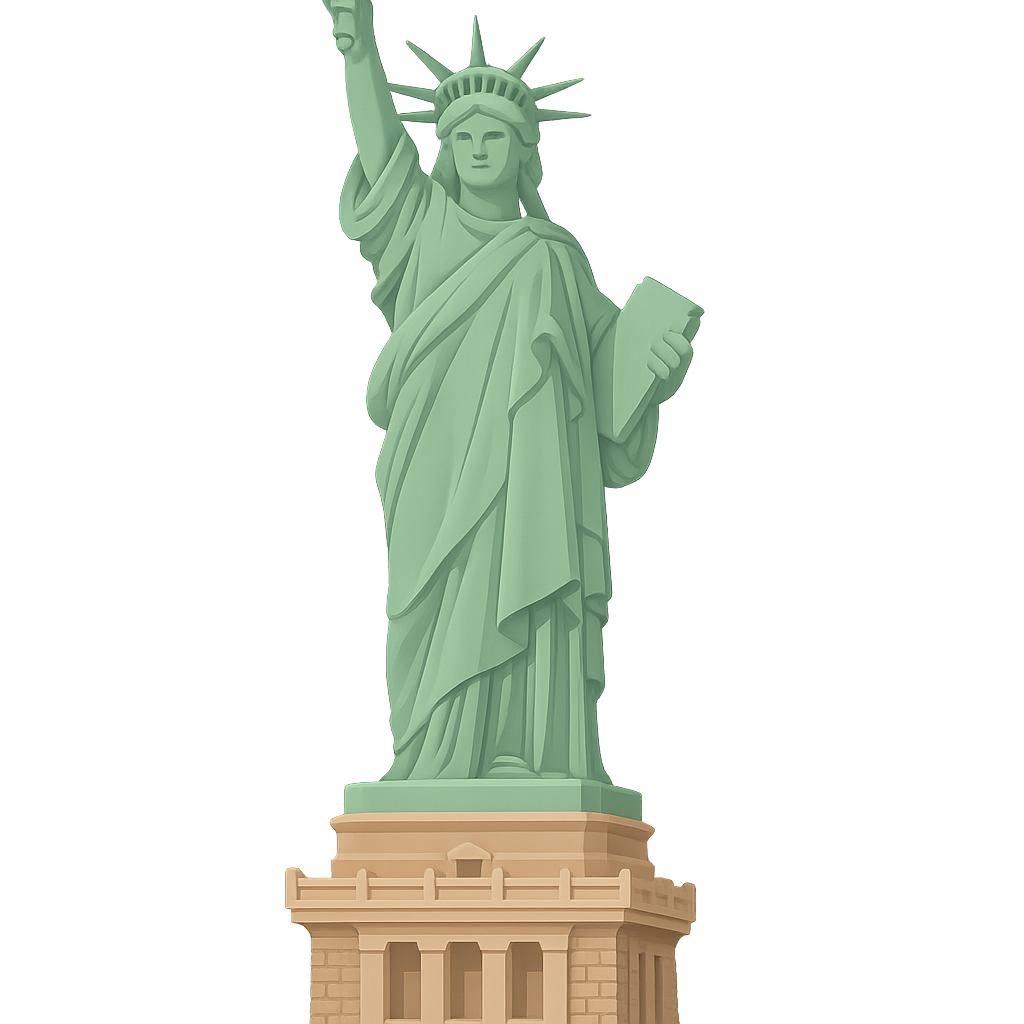The Voice of the Harbor
From my island home, I feel the salty sea breeze brush against my skin, a cool whisper on a warm day. The sun warms my green copper surface as I gaze toward a city of towering glass and steel. Below me, tiny boats crisscross the harbor like waterbugs, their engines a distant hum. For more than a century, I have stood here, silent and steady. In one arm, I hold a tablet marked with a date of great importance: July 4, 1776. In my other hand, I raise a golden torch high into the sky, a beacon that never goes out. A crown with seven sharp spikes, representing the seven continents and seven seas, rests upon my head. I have watched generations of people arrive on these shores, their faces filled with hope and wonder. They look up at me, and I look down at them, a silent promise passing between us. I am the Statue of Liberty, but you can call me Lady Liberty.
My story did not begin here in America, but across the vast Atlantic Ocean, in France. It was an idea born from friendship in the year 1865. A thoughtful Frenchman named Édouard de Laboulaye proposed that our countries should create something together to celebrate the hundredth anniversary of American independence and the strong bond between our nations. He believed that liberty was a value that connected all people, and he wanted a monument that would stand for that ideal forever. His idea sparked the imagination of a talented sculptor, Frédéric Auguste Bartholdi. Bartholdi traveled to America to find the perfect home for me. As his ship sailed into New York Harbor, he saw a small island called Bedloe's Island and knew at once that this was the place. It was the gateway to America. He envisioned me not as a warrior with a sword, but as a peaceful greeter, welcoming all who came seeking freedom and a new beginning. He wanted my light to be a guide, a symbol of enlightenment for the world.
Turning that grand vision into a reality was a monumental task. Back in a busy workshop in Paris, my creation began. The air was filled with the constant clang of hammers as skilled artisans meticulously shaped thin sheets of copper over massive wooden molds. This technique, called repoussé, allowed my skin to be both strong and relatively light. But how would I stand against the fierce winds of the harbor? That was a puzzle for a brilliant engineer, a man you may have heard of: Gustave Eiffel. Yes, the very same man who would later build the famous tower in Paris. In 1881, he designed my secret. He gave me a flexible iron skeleton, an internal framework that acts like a spine, allowing me to sway ever so slightly in the wind without ever falling. For years, I was built piece by piece, until I stood fully assembled over the rooftops of Paris in 1884, a preview for the French people. Then came the great disassembly. In 1885, I was carefully taken apart into 350 pieces, packed into 214 wooden crates, and placed aboard a ship called the Isère for my long journey to a new home.
While I was being built in France, a different challenge was unfolding in America. I needed a pedestal, a grand stone base to stand upon, but raising money for it was proving difficult. The project stalled. It seemed I might remain in my crates forever. Then, a newspaper publisher named Joseph Pulitzer of the New York World stepped in. He believed that I belonged to everyone, not just the wealthy. In 1885, he launched a fundraising campaign in his newspaper, asking all Americans to contribute, no matter how small the amount. He printed the name of every single person who donated. Schoolchildren sent in their pennies, and families sent their dimes. The people answered his call, and soon, the money for my pedestal was raised. When my crates finally arrived, the city celebrated. Over the next year, workers pieced me back together on my newly finished base. Finally, on October 28, 1886, on a rainy and foggy day filled with cheering crowds and boats tooting their horns, I was officially dedicated. I was finally home.
In the years that followed, my purpose began to deepen. I was no longer just a gift of friendship. I became the first sight of America for millions of immigrants who sailed past me on their way to Ellis Island. For them, I was the very picture of hope, the promise of a life free from poverty and persecution. In 1903, a bronze plaque was placed on my pedestal, giving me a voice. It carried the words of a poet named Emma Lazarus, from her poem 'The New Colossus.' Her famous lines, 'Give me your tired, your poor, Your huddled masses yearning to breathe free,' defined my new role as the Mother of Exiles. Today, I still stand for that promise. I am a reminder that friendship between nations can create beautiful things and that freedom is a light worth holding high for the entire world to see.
Reading Comprehension Questions
Click to see answer
